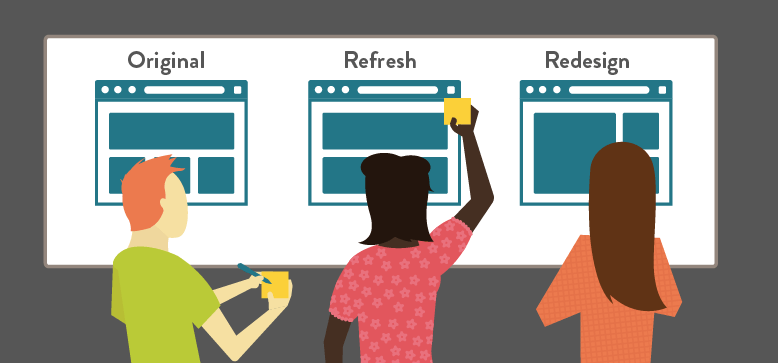When you Should—and Shouldn’t—Consider Redesigning your Website

In this post, we discuss important considerations when redesigning your website. We also cover when other options might be better for your budget and schedule.
For many organizations, website redesigns are simultaneously exciting and terrifying prospects. Every three years—give or take—the old site is completely scrapped and a shiny new one takes its place. Teams frantically review designs, labor over content, and test the smallest details in prototypes for months on end—only to launch the site and do it all over again a few years later.
This process can be expensive and ineffective, but it doesn’t have to be. With so much hinging on your site’s success, it’s just as important to consider how to create a new website as what it will contain, so we’ve put together some new ways to approach and streamline the process.
For this post, we’ll use an analogy of redesigning your living room to give these concepts more clarity.

What’s Wrong with Your Current Site?
Before starting any website redesign, be sure to ask why your current site isn’t working. Knowing this can help to determine:
- How much work it might take to reach your goals
- The best approach to take
To this end, here are seven common frustrations we hear from potential clients about their existing sites:
1. We don’t like how the site looks
A site’s design sets the first impression, so it’s no surprise that organizations are keen to keep their sites visually appealing. Often, we’re approached about a redesign when the visual aesthetics of a website feel outdated or no longer match the organization’s branding.
2. Site functionality doesn’t work well
Organizations looking for new or updated functionality on a website often take the opportunity to redesign their site. Sometimes new functionality will have an impact across the entire site (e.g., the ability to make purchases on what was previously a brochure site) and other times it is specific to a page or section.
3. Our site isn’t generating enough leads
It’s common for an organization to want a fresh start if their current website isn’t generating enough leads or sales. This stems from the notion that you can get better results from a brand new site than from fixing one that is broken. However, in reality, this isn’t always the case.
4. Our site’s users can’t find the content they need
Large sites can become cumbersome for users and administrators, so it’s not surprising when an organization wants to start over. A website redesign offers a great opportunity to run a content audit and rethink information architecture, helping to pare down and organize existing content.
5. The CMS and integrations are outdated
When a site’s technology starts to hinder its ability to function well, it might be time for a new site. The content management system, third-party integrations, and code create a site’s foundation. If they aren’t working properly, then the site won’t either.
6. The site isn’t helping us achieve our goals
An organization’s marketing goals evolve over time. If your site can’t keep up then it’s time to consider making a change. Your site has to deliver on your marketing goals. Otherwise, it will never be an effective tool for your business or organization.
7. The site is difficult to update
Web administrators are often a website’s forgotten users. However, their ability to easily update content is essential to a site’s success. Improving this experience makes a website more efficient and effective.
Website Refresh vs. Redesign
As someone that takes a lot of pride in the product we ship, it’s tempting to make it look better and fiddle with pixels without having the self-awareness to question, ‘Is this actually going to change how people use the product? Will it meaningfully impact our metrics?’ Don’t let your ego get in the way of prioritizing what’s right for the business and your users.
— Ryan Hoover, Founder of Product Hunt
There are two general approaches to revamping a website—a refresh or a redesign.

Website Refresh
A new website doesn’t mean you have to start from scratch, sometimes you just need to make some updates to your existing site in order to get it looking and working as you want it to. A refresh can be used to make major changes to a site, but instead of building it from the ground up, you’re updating and changing what you already have.
Think of a website refresh like getting new furniture for a room—it’s the same room you had before but you’ve made it look different and work better for you. This approach is easier, quicker, and requires fewer resources at any given time. However, it may have limitations based on the technology you are using and how the site currently works.

Website Redesign
A redesign is what most people think of when they start planning a new site. A proper redesign involves designing, developing, and structuring a new site from scratch. It’s like tearing down a room, rebuilding it from the ground up, and then adding a new paint color, carpeting, furniture, etc.
This process is more complex, slower, and more expensive than a refresh but sometimes can get you better value for the money. Think of it this way: if your website needs so much work that it will take longer to undo and fix what exists than starting over, then a redesign is probably the best option for you.
The best way to figure out which approach is right for your organization is to have an honest conversation with a digital agency about what you need from a new site—your goals, existing problems, budget, and timeline. It’s also important to leave personal preferences aside and focus on what is right for the organization:
Three Ways to Build Websites
Once you know whether you are moving ahead with a refresh or a redesign, you can determine which production process to use. The goal is to build a site that works better than what you already have and then improve the site based on user feedback. It’s also important to understand your customer buying process so each step in the sales funnel can be included in the initial launch.
This ensures that your new website can generate leads and sales from the start. At Mightybytes, we use three different processes when creating or updating websites. Regardless of which process we use, we combine strategy and test-driven results to help us optimize our sites for our clients and their users:
1. Low-Hanging Fruit
In some cases, an organization just needs to fix things that are broken, so the majority of the site can be left as is. This approach primarily focuses on updating the broken elements of a site. Typically these are functionality fixes, but they could also extend to changing messaging, relocating existing pages in the site architecture, carrying out a content audit, or removing administrators that no longer need to have access to the site. These quick fixes can get the site back to its original glory without much time or investment.
2. Quick Launch
The goal of this process is to launch the initial site quickly and then follow that up with additional updates and conversion rate optimization based on what post-launch data analysis, i.e. what resonates with users. To achieve this, the initial site is launched only with what is “mission critical” to the site’s ability to convert users. After launch, secondary functionality and content is added as needed, and conversion rate testing begins. Think of this like you would an app on your phone—the initial launch is followed by regular feature updates that help improve its usability and security. ‘
The benefit of this approach is that you are able to get something up and running quickly, which means you can look at user data to determine how users are engaging with the site and what next steps would be worth taking.
3. Traditional Redesign
There are some situations when a full site is required at launch. This tends to occur when all the moving pieces need to work together to achieve the site’s goals. A good example of this is an e-commerce site, where the full product catalog, shopping cart and payment gateway have to exist in order for a purchase to be made.
While this approach does take longer to get to launch than the other options, its strength is that you are able to have everything up and running at once.
Redesigning Your Website? Final Thoughts
A new website can significantly impact an organization’s business goals. However, a refreshed website can help you quickly solve problems that get in your way without rethinking the entire product.
Planning which approach to take at the beginning of the project will increase your chances for enduring success. Either way, it’s important to work with an agency partner that can guide you through the process—whatever that ends up being.



